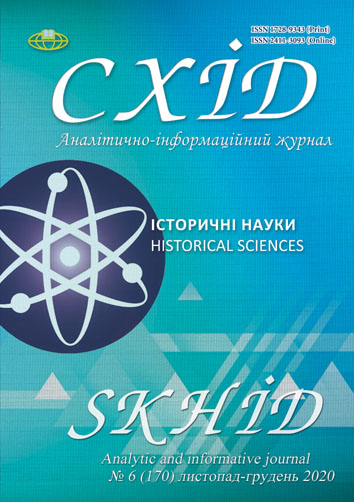ANTI-SEMITIC PROPAGANDA OF NAZI GERMANY IN THE OCCUPIED TERRITORIES OF UKRAINE DURING 1941-1944
DOI:
https://doi.org/10.21847/1728-9343.2020.6(170).218801Keywords:
anti-Semitism policy, World War II, German-Soviet war, propaganda, mediaAbstract
During World War II, anti-Semitism reached its highest level of cruelty, especially in the occupied territories of Ukraine. The article revealed the German occupation policy, which adhered to the principle of conflict creation between different peoples and ethnic groups, who inhabited the Reich Commissariat “Ukraine” and the area of military administration. The article also covered the periodicals, leaflets, caricatures, all kinds of proclamations, propaganda campaigns as means of anti-Semitic propaganda were aimed at creating a terrible image of the Jew. The most widespread in Nazi propaganda was the accusation of Jews of crimes by the Bolshevik Stalinist regime. It has been proven that the open call for the extermination of Jews as bearers of Bolshevik ideology and practice was made through Nazi propaganda. It was found that the influence of Nazi propaganda on the population of the occupied territories was huge, which forced the Soviet troops to intensify their own propaganda after returning to their territories. In general, German agitation and propaganda activities played a significant role in advancing the Nazi army deep into the USSR, but the inconsistent policy of the German occupation authorities undermined the information principles it had created. The Nazi occupation policy led to the total annihilation of the Jewish people in the occupied territories of Ukraine. The moral and psychological condition of the population of the occupied territories was extremely difficult, people no longer believed that the German authorities would fulfill the promises they had mentioned in their propaganda. The political forces of Nazi Germany and the Soviet Union used the most modern methods and means of influencing the population of opposing and military opponents.Downloads
References
Averbukh, S.L. (comp). (2005). Gitlerovskaya propaganda yudofobii v proklamatsiyah i karikaturah. Kiev: Ukrainskiy Tsentr izucheniya Holokosta (In Russian).
Dashychev, V.I. (ed.) (1973). Zamechaniya i predlozheniya "vostochnogo ministerstva" po generalnomu planu "OST". In: Bankrotstvo strategii germanskogo fashizma. Istoricheskiye ocherki, dokumenty i materialy, Moscow: Nauka, Vol. 2, s. 30-41. Retrueved from https://scepsis.net/library/id_703.html (In Russian)
Der Prozeß gegen die Hauptkriegsverbrecher vor dem Internationalen Militärgerichtshof. (1947). Interrogation of witness Erich von Bach-Celewski, January 7, 1946. Bd. 4. Nürnberg, 536 s. (In German)
Der Prozeß gegen die Hauptkriegsverbrecher vor dem Internationalen Militärgerichtshof. (1949). Bd. 38. Nürnberg,. Dok. L-221 (In German).
Gogun, A. (2004). Chernyiy PR Adolfa Gitlera: Dokumentyi i materialyi. Moscow: Eksmo, Yauza (In Russian).
Halchak, S.D. (2004). «Skhidni robitnyky» z Podillia u Tretomu reikhu: Dokumenty, natsystska katorha, opir ponevoliuvacham. Ukrainskyi natsionalnyi fond «Vzaiemorozuminnia i prymyrennia» ta in. Vinnytsia: Knyha-Veha, 67-68 (In Ukrainian).
Hitler’s Table Talk 1941-1944. (1953). Trevor-Roper. London, 13.
Kalakura, Ya.S. (2004). Ukrainska istoriohrafiia. Kyiv. Heneza. (In Ukrainian).
Klemperer, V. (1998). LTI: Yazyik Tretego Reyha: Zapisnaya knizhka filologa A.B.Grigoreva [translat.from german]. Moscow: Progress-Traditsiya (In Russian).
Korol, V.Yu. (2006). Vtrachene, ale ne zabute: z istorii pamiatok tserkovnoi arkhitektury Kyivshchyny. Kyiv. VTs «Akademiia»: 85-87 (In Ukrainian).
Kostyirchenko, G.V. (2003). Taynaya politika Stalina: vlast i antisemitizm. Moscow: Mezhdunar. otnosheniya (In Russian).
Kosyk, V. (1993). Ukraina i Nimechchyna u Druhii svitovii viini [transl.from French]. Paris-N.Y.-Lviv: 371-372 (In Ukrainian).
Kosyk, V. (1998). Ukraina Druhii svitovii viini u dokumen-takh: Zbirnyk nimetskykh arkhivnykh materialiv. Lviv. Vol. 2: 157. (In Ukrainian).
Kruglov, O. (2008). O kolichestve evreev, unichtozhennyih eynzattsgrupami v 1941-1943 gg. Golokost I suchasnIst. Naukoviy chasopis. 1: 47-51 (In Russian).
Laynbardzher, P. (2015). Psihologicheskaya voyna. Teoriya i praktika obrabotki massovogo soznaniya. Kiev. Tsentrpoligraf. S. 17-18 (In Russian).
Lyakhovitsky, Yu. M. (1991). Poprannaya mezuza. Kniga Drogobitskogo Yara: Svidetelstva, faktyi, dokumentyi o natsistskom genotside evreyskogo naseleniya Harkova v period okkupatsii 1941-1942 gg. Kharkov, W.p. (In Russian).
Lyakhovitsky, Yu.M. (ed.) (1992). Holocaust in Ukraine and anti-Semitism in perspective. Kharkov: Kharkov Society of Jewish Culture. S. 99-114 (In Russian).
Mykhailiuk, M.V. (2006). Natsystska propahanda v oku-povanomu Kyievi. Ukrainskyi istorychnyi zhurnal. 1: 131-144 (In Ukrainian).
Podolskiy, A. (2007). Problema kollaboratsii na Ukrainev period Kholokosta: nekotoryie aspektyi issledovaniya i istoriografii. Proceeding Papers, Kyiv, 2006, October, 30-31. Kyiv: Zovnishnotorhvydav: 386 (In Ukrainian).
Sbornik dokumentov i materialov ob unichtozhenii natsistami evreyev Ukrainyi v 1941-1944 godakh. (2002). Kiev. S. 76-77. (In Russian)
Tytarenko, D.M. (2005). Zvity batalionu propahandy U yak dzherelo z pytannia pro vplyv natsystskoi propahandy na naselennia okupovanoi Ukrainy. Druha svitova viina i dolia narodiv Ukrainy: Proceeding Papers. Kyiv. S. 165-171 (In Ukrainian).
Vashik, Klaus. (2002). Metamorfozyi zla. Obraz vraga v nemetskom i sovetskom plakate. Rodina, 10: 16 (In Russian).
Vronska, T. V. (comp.), Kentiy, A. V. (comp.), Kokin, S. A. (comp.), Lysenko, O. Ye. (comp.), Smyrnov, H. V. (comp.) (2003). Kyiv u dni natsystskoi navaly: Za dokumentamy radianskykh spetssluzhb. Kyiv-Lviv. (In Ukrainian)
Vynokurova, F.A. (2007). Vyrishennia «ievreiskoho py-tannia» v okhoronnii zoni poblyzu Stavky Hitlera (ohliad dzherel). Proceeding Papers, Kyiv, 2006, October, 30-31. Kyiv: Zovnishnotorhvydav: 221 (In Ukrainian).
Yevstafieva, T.O. (2007). Trahediia Babynoho Yaru (1941-1945). Proceeding Papers, Kyiv, 2006, October, 30-31. Kyiv: Zovnishnotorhvydav: 265 (In Ukrainian).
Downloads
Published
How to Cite
Issue
Section
License
Copyright (c) 2020 Oksana Salata

This work is licensed under a Creative Commons Attribution-NonCommercial-NoDerivatives 4.0 International License.
1. Authors bear responsibility for the accuracy of facts, quotations, numbers and names used.
2. Manuscripts are not sent back.
3. The publisher does not always agree with the authors' opinion.
4. The authors reserve the right to authorship of the work and pass the first publication right of this work to the journal under the terms of a Creative Commons Attribution-NonCommercial-NoDerivatives 4.0 International License. This license allows others to distribute (copy) the published work for non-commercial purposes, provided there is mandatory attribution to its authors and a link to the first publication in our journal.
5. The authors have the right to conclude separate supplement agreements that relate to non-exclusive work distribution in the form in which it has been published by the journal (for example, to upload the work to the online storage of the journal or publish it as part of a monograph), provided that the reference to the first publication of the work in this journal is included.

